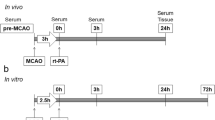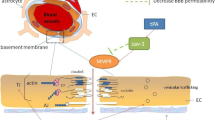Abstract
The role of the inflammatory agent fibrinogen (Fg) in increased pial venular permeability has been shown previously. It was suggested that an activation of matrix metalloproteinase-9 (MMP-9) is involved in Fg-induced enhanced transcytosis through endothelial cells (ECs). However, direct link between Fg, caveolae formation, and MMP-9 activity has never been shown. We hypothesized that at an elevated level, Fg enhances formation of functional caveolae through activation of MMP-9. Male wild-type (WT, C57BL/6J) or MMP-9 gene knockout (MMP9−/−) mice were infused with Fg (4 mg/ml, final blood concentration) or equal volume of phosphate buffered saline (PBS). After 2 h, mice were sacrificed and brains were collected for immunohistochemical analyses. Mouse brain ECs were treated with 4 mg/ml of Fg or PBS in the presence or absence of MMP-9 activity inhibitor, tissue inhibitor of metalloproteinases-4 (TIMP-4, 12 ng/ml). Formation of functional caveolae was assessed by confocal microscopy. Fg-induced increased formation of caveolae, which was defined by an increased co-localization of caveolin-1 (Cav-1) and plasmalemmal vesicle-associated protein-1 and was associated with an increased phosphorylation of Cav-1, was ameliorated in the presence of TIMP-4. These results suggest that at high levels, Fg enhances formation of functional caveolae that may involve Cav-1 signaling and MMP-9 activation.






Similar content being viewed by others
References
Mehta, D., & Malik, A. B. (2006). Signaling mechanisms regulating endothelial permeability. Physiological Reviews, 86, 279–367.
Lominadze, D., Dean, W. L., Tyagi, S. C., & Roberts, A. M. (2010). Mechanisms of fibrinogen-induced microvascular dysfunction during cardiovascular disease. Acta Physiologica, 198, 1–13.
Simionescu, M., Popov, D., & Sima, A. (2009). Endothelial transcytosis in health and disease. Cell and Tissue Research, 335, 27–40.
Komarova, Y., & Malik, A. B. (2010). Regulation of endothelial permeability via paracellular and transcellular transport pathways. Annual Review of Physiology, 72, 463–493.
Stan, R.-V., Marion, K., & Palade, G. E. (1999). PV-1 is a component of the fenestral and stomatal diaphragms in fenestrated endothelia. Proceedings of the National Academy of Sciences of the United States of America, 96, 13203–13207.
Razani, B., Woodman, S. E., & Lisanti, M. P. (2002). Caveolae: From cell biology to animal physiology. Pharmacological Reviews, 54, 431–467.
Yu, J., Bergaya, S., Murata, T., Alp, I. F., Bauer, M. P., Lin, M. I., et al. (2006). Direct evidence for the role of caveolin-1 and caveolae in mechanotransduction and remodeling of blood vessels. Journal of Clinical Investigation, 116, 1284.
Parton, R. G., & Simons, K. (2007). The multiple faces of caveolae. Nature Reviews Molecular Cell Biology, 8, 185–194.
Hnasko, R., McFarland, M., & Ben-Jonathan, N. (2002). Distribution and characterization of plasmalemma vesicle protein-1 in rat endocrine glands. Journal of Endocrinology, 175, 649–661.
Mozer, A., Whittemore, S., & Benton, R. (2010). Spinal microvascular expression of PV-1 is associated with inflammation, perivascular astrocyte loss, and diminished EC glucose transport potential in acute SCI. Current Neurovascular Research, 7, 238–250.
Shue, E., Carson-Walter, E., Liu, Y., Winans, B., Ali, Z., Chen, J., et al. (2008). Plasmalemmal vesicle associated protein-1 (PV-1) is a marker of blood–brain barrier disruption in rodent models. BMC Neuroscience, 9, 29.
Carson-Walter, E., Hampton, J., Shue, E., Geynisman, D., Pillai, P., Sathanoori, R., et al. (2005). Plasmalemmal vesicle associated protein-1 is a novel marker implicated in brain tumor angiogenesis. Clinical Cancer Research, 11, 7643–7650.
Rosell, A., Ortega-Aznar, A., Alvarez-Sabin, J., Fernandez-Cadenas, I., Ribo, M., Molina, C. A., et al. (2006). Increased brain expression of matrix metalloproteinase-9 after ischemic and hemorrhagic human stroke. Stroke, 37, 1399–1406.
Phillips, P. G., & Birnby, L. M. (2004). Nitric oxide modulates caveolin-1 and matrix metalloproteinase-9 expression and distribution at the endothelial cell/tumor cell interface. American Journal of Physiology.Lung Cellular and Molecular Physiology, 286, L1055–L1065.
Munjal, C., Tyagi, N., Lominadze, D., & Tyagi, S. (2012). Matrix metalloproteinase-9 in homocysteine-induced intestinal microvascular endothelial paracellular and transcellular permeability. Journal of Cellular Biochemistry, 113, 1159–1169.
Danesh, J., Lewington, S., Thompson, S. G., Lowe, G. D., Collins, R., Kostis, J. B., et al. (2005). Plasma fibrinogen level and the risk of major cardiovascular diseases and nonvascular mortality: An individual participant meta-analysis. JAMA, 294(14), 1799–1809.
Ross, R. (1999). Mechanisms of disease—Atherosclerosis—An inflammatory disease. New England Journal of Medicine, 340, 115–126.
Tyagi, N., Roberts, A. M., Dean, W. L., Tyagi, S. C., & Lominadze, D. (2008). Fibrinogen induces endothelial cell permeability. Molecular and Cellular Biochemistry, 307, 13–22.
Patibandla, P. K., Tyagi, N., Dean, W. L., Tyagi, S. C., Roberts, A. M., & Lominadze, D. (2009). Fibrinogen induces alterations of endothelial cell tight junction proteins. Journal of Cellular Physiology, 221, 195–203.
Kerlin, B., Cooley, B. C., Isermann, B. H., Hernandez, I., Sood, R., Zogg, M., et al. (2004). Cause–effect relation between hyperfibrinogenemia and vascular disease. Current Opinion in Hematology, 103, 1728–1734.
Muradashvili, N., Tyagi, N., Tyagi, R., Munjal, C., & Lominadze, D. (2011). Fibrinogen alters mouse brain endothelial cell layer integrity affecting vascular endothelial cadherin. Biochemical and Biophysical Research Communications, 413, 509–514.
Muradashvili, N., Qipshidze, N., Munjal, C., Givvimani, S., Benton, R. L., Roberts, A. M., et al. (2012). Fibrinogen-induced increased pial venular permeability in mice. Journal of Cerebral Blood Flow and Metabolism, 32, 150–163.
Lincoln, D. W., Larsen, A. M., Phillips, P. G., & Bove, K. (2003). Isolation of murine aortic endothelial cells in culture and the effects of sex steroids on their growth. In Vitro Cellular and Developmental Biology. Animal, 39, 140–145.
Manders, E. M. M., Verbeek, F. J., & Aten, J. A. (1993). Measurement of co-localization of objects in dual-colour confocal images. Journal of Microscopy, 169, 375–382.
Hu, G., Vogel, S. M., Schwartz, D. E., Malik, A. B., & Minshall, R. D. (2008). Intercellular adhesion molecule-1-dependent neutrophil adhesion to endothelial cells induces caveolae-mediated pulmonary vascular hyperpermeability. Circulation Research, 102, e120–e131.
Sun, Y., Hu, G., Zhang, X., & Minshall, R. D. (2009). Phosphorylation of caveolin-1 regulates oxidant-induced pulmonary vascular permeability via paracellular and transcellular pathways. Circulation Research, 105, 676–685.
Wei, E., Hamm, R., Baranova, A., & Povlishock, J. (2009). The long-term microvascular and behavioral consequences of experimental traumatic brain injury after hypothermic intervention. Journal of Neurotrauma, 26, 527–537.
Parton, R. G., Joggerst, B., & Simons, K. (1994). Regulated internalization of caveolae. The Journal of Cell Biology, 127, 1199–1215.
Minshall, R. D., Tiruppathi, C., Vogel, S. M., Niles, W. D., Gilchrist, A., Hamm, H. E., et al. (2000). Endothelial cell-surface gp60 activates vesicle formation and trafficking via G(i)-coupled Src kinase signaling pathway. The Journal of Cell Biology, 150, 1057–1070.
Shajahan, A. N., Timblin, B. K., Sandoval, R., Tiruppathi, C., Malik, A. B., & Minshall, R. D. (2004). Role of Src-induced dynamin-2 phosphorylation in caveolae-mediated endocytosis in endothelial cells. Journal of Biological Chemistry, 279, 20392–20400.
Chang, C.-F., Chen, S.-F., Lee, T.-S., Lee, H.-F., Chen, S.-F., & Shyue, S.-K. (2011). Caveolin-1 deletion reduces early brain injury after experimental intracerebral hemorrhage. The American Journal of Pathology, 178, 1749–1761.
Williams, T. M., Medina, F., Badano, I., Hazan, R. B., Hutchinson, J., Muller, W. J., et al. (2004). Caveolin-1 gene disruption promotes mammary tumorigenesis and dramatically enhances lung metastasis in vivo: Role of Cav-1 in cell invasiveness and matrix metalloproteinase (MMP-2/9) secretion. Journal of Biological Chemistry, 279, 51630–51646.
Miyawaki-Shimizu, K., Predescu, D., Shimizu, J., Broman, M., Predescu, S., & Malik, A. B. (2006). siRNA-induced caveolin-1 knockdown in mice increases lung vascular permeability via the junctional pathway. American Journal of Physiology. Lung Cellular and Molecular Physiology, 290, L405–L413.
Muradashvili, N., Tyagi, R., & Lominadze, D. (2012). A dual-tracer method for differentiating transendothelial transport from paracellular leakage in vivo and in vitro. Frontiers in Physiology, 3, 166–172.
Cameron, P. L., Ruffin, J. W., Bollag, R., Rasmussen, H., & Cameron, R. S. (1997). Identification of caveolin and caveolin-related proteins in the brain. The Journal of Neuroscience, 17, 9520–9535.
Hill, M. M., Scherbakov, N., Schiefermeier, N., Baran, J., Hancock, J. F., Huber, L. A., et al. (2007). Reassessing the role of phosphocaveolin-1 in cell adhesion and migration. Traffic, 8, 1695–1705.
Acknowledgments
Grant sponsors: Contract grant sponsor: NIH; Contract Grant Numbers: P30 GM-103507 (to DL), NS-084823 (to DL and SCT), HL-071010 (to SCT), and NS-051568 (to SCT).
Author information
Authors and Affiliations
Corresponding author
Rights and permissions
About this article
Cite this article
Muradashvili, N., Benton, R.L., Tyagi, R. et al. Elevated Level of Fibrinogen Increases Caveolae Formation; Role of Matrix Metalloproteinase-9. Cell Biochem Biophys 69, 283–294 (2014). https://doi.org/10.1007/s12013-013-9797-z
Published:
Issue Date:
DOI: https://doi.org/10.1007/s12013-013-9797-z




